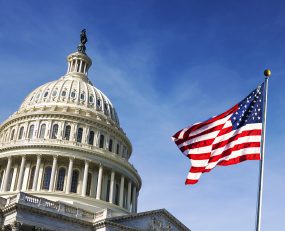
Former President Trump believes that the US has been the victim of globalisation. If re-elected, he intends to re-industrialise America whatever the cost to the global trade regime, with Europe now firmly in the crosshairs.
Given the possibility – some would say probability – that the American electorate will once again elect Donald Trump as President later this year, politicians around the world are taking his pronouncements increasingly seriously. His latest speech in which he refused to commit to the protection of ‘delinquent’ NATO allies, i.e. those that failed to spend 2% of their GDP on defence, has sent shock waves around Europe. This, of course, was his precise intention.
Although less reported, his views on international trade are just as incendiary. His previous tenure as President was largely characterised (to foreign eyes at least) by his refusal to sign up to a trade deal with Asian countries; the re-negotiation of NAFTA; the marginalisation of the World Trade Organisation (WTO); a trade war with China and deteriorating trade relations with the EU. Recent speeches suggest that his approach to foreign trade will be even more robust in his second term. Although China is clearly in his sights, Europe will not be immune from his trade policies.
Trump clearly believes (as do a large number of Americans) that globalisation has been a disaster for the US economy, transferring jobs and technological know-how to foreign adversaries. There is indeed some truth in his view. In 2001, the same year that China joined the WTO, there were still 17.1 million manufacturing jobs in the US. Three years later this figure had dropped to 14.3 million, falling to 11.5 million after the Great Recession of 2008-9. The result was the creation of so-called ‘rust belts’ as formerly prosperous industrial areas became derelict. Of course, the root causes are much more complicated than just off-shoring but this is the popular narrative, asserting that American workers were the victims of a globalist agenda in which politicians, well paid executives and shareholders benefited at their expense.
President Trump’s response was to impose duties on imports of Chinese (and some European) goods as well as punishing those institutions which he held responsible for facilitating the destruction of American manufacturing, such as the WTO. The problem with his approach, however, was that it generated huge costs, largely borne by US businesses and consumers. It has been estimated that the tariffs cost US households an additional $600 a year, US companies paid $46 billion in tariffs and 300,000 jobs were lost.
These eye-watering figures have not diminished President Trump’s desire for ‘more of the same’. In fact, he has already committed to going much further, saying that he will impose a 10% tariff on all imports from whichever country they originate. Some analysts believe that this policy is designed to destroy the existing global trade regime in order to re-industrialise the USA, by whatever means possible.
The policy has inevitably attracted criticism from many quarters although, notably, Democrats have not condemned it out of hand. Janet Yellen, the Treasury Secretary, for example, said that whilst it would raise the cost of products, she was open to more tariffs on some goods. Others have been more strident in their response. The Tax Foundation, a Washington think tank, estimated that the tariffs would cost US consumers a further $300 billion and, talking to CNBC, the American Action Forum said it would, “distort global trade, discourage economic activity, and have broad negative consequences for the US economy.”
The repercussions of Trump’s trade policy will not just be felt domestically. It would inevitably invite a reaction by US trade partners, resulting in multiple trade wars. Europe would certainly not be immune to the fall out and, indeed, trade tensions would reinforce the position of those in Europe who are already calling for ‘strategic autonomy’, such as France’s President Macron. Disagreements over security spending, industrial strategy and international trade would coalesce to provide for toxic foreign relations, further splintering Western alliances and leading to political and economic fragmentation.
Indeed, recent news reports suggest that trade with the European Union will be a policy priority if Trump is elected, in much the same way that he targeted the Trans Pacific Partnership (TPP) in the early days of his first presidency. Not only will he impose across-the-board tariffs, with more punishing levies targeted at European automakers, but counter-measures against the EU’s digital services tax (which fall heavily on US tech companies) are to be expected. A large balance of trade deficit, imports of cheap European iron and steel and Europe’s weak stance, as he sees it, on China are behind his frustrations.
Critical to the future of global supply chains will be whether Trump’s threats of a worldwide trade war are part of a negotiating tactic or whether they form part of a policy to dismantle international trade networks which he views as fundamentally malign. He does not believe in the concept of comparative advantage in which trade benefits both parties. Instead, trade is always a battle with winners and losers, and his view is that the American people have lost out for too long. Policy makers in Europe would do well to understand that Trump may not be looking for a deal. His ambitions of a re-industrialized America go way beyond the trade spats and bickering of previous administrations.
Author: John Manners-Bell
Source: Ti Insight
Supply chain strategists can use GSCi – Ti’s online data platform – to identify opportunities for growth, support strategic decisions, help them stay abreast of industry trends and development, as well as understand future impacts on the industry.
Visit GSCI subscription to sign up today or contact Michael Clover for a free demonstration: [email protected] | +44 (0) 1666 519907